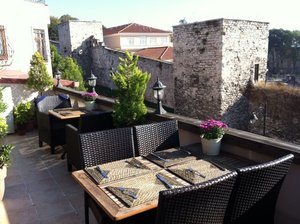Advertisement
Published: July 22nd 2017

 Breakfast on the Terrace
Breakfast on the Terrace
Topkapi Palace in the background.Geo: 41.0067, 28.9816
We are located in the old historical area of the city known as Sultanahmet. In fact across the street are the ruins on the grounds of the Topkapi Palace which is a designated World Heritage Site. We visited the Blue Mosque, Hagia Sophia, the Basilica Cisterns and various other sights. There is also an International Festival occurring in the city at the moment.
The Blue Mosque is still operating as a religious institution. Entry requires one to remove shoes as well as keeping certain body areas covered. Sultan Ahmed I decided to build this mosque following wars with Persia. It was built on the site of a palace of the Byzantine emperors facing the Hagia Sophia and the hippodrome. Construction started in 1609 and opened in 1617. It is one of the most impressive monuments in the world. It is one of 2 mosques in Istanbul with 6 minarets.
Hagia Sophia Museum was first a basilica, later a mosque and now a museum. From 360 to 1453 it was the Greek Patriarchal cathedral of Constantinople. It then became a mosque and in 1931 it was closed and reopened in 1935 as a museum. It has served as a focus
for the Eastern Orthodox religions and is Byzantine in appearance. It was the largest cathedral in the world until the completion of the Seville Cathedral in 1520. The current building was constructed between 532 and 537 under the orders of the Byzantine Emperor Justinian and was the third Church of Holy Wisdom to occupy the site. At the time of the conversion to a mosque many of the mosaics were plastered over and religious artifacts removed. Praying is now forbidden because of the museum status.
The Basilica Cistern built by Justinian in 532 is a massive underground feature which was designed to hold 80,000 cubic meters of water and was connected to 20 km of aqueducts. It is 65 m wide and 143 m long and there are 336 columns arranged in 12 rows. The columns were salvaged from other structures and reused. It is built beneath one of the squares and supplied water for the Great Palace and surrounding buildings. It was rediscovered in 1545 when a scholar Petrus Gyllius was told about locals gathering water and catching fish by lowering buckets in their basement floors.
The weather is very pleasant. Temp probably 30 C but there is a bit
of a breeze from the Sea of Marmara. The Call to Prayer from the speakers on the minarets takes a bit of getting used to. It occurs 5 times a day - once at dawn. We went for dinner a little later tonight when it cools down which is in fact a difference of only a couple of degrees day/night. Dinner was at the Palatium Restaurant which has parts of an underground city which has been featured on the History Channel. The excavation work has been done by the owner of the restaurant.
Advertisement
Tot: 0.179s; Tpl: 0.013s; cc: 6; qc: 44; dbt: 0.0607s; 1; m:domysql w:travelblog (10.17.0.13); sld: 1;
; mem: 1.1mb

 Breakfast on the Terrace
Breakfast on the Terrace







CRW
non-member comment
Dear Mr. and Ms. Itchy Feet: Mighty fine photos of your adventure so far. But please travel safe and remember you left behind record-breaking warm and dry weather. This is the one fall you could have stayed behind and not got wet!